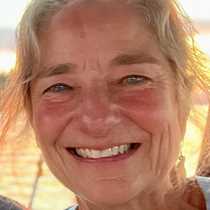This morning we explored Iyoukeen, a wide cove on the shores of Chatham Strait. In the early 1900s this peaceful area was the site of a gypsum mine. At that time there was a mile-long rail track leading to a long wharf where ships loaded up with gypsum. Today just a few pilings remain and rain forest has reclaimed most of the site.
In the lush forest, just beyond the first row of spruce trees, was a bear trail. On one section large oval depressions were pressed into the moss where they have walked for many years. It was luxuriously soft for walking—if only sidewalks could be so soft! We found clumps of deer fur, and a jaw, leg bones and a hoof; did a bear kill the deer? Bears had marked some trees, leaving bits of brown fur near claw scratch marks. All around us were clues to the lives of forest dwellers. When we peered under an old, leaning tree, we discovered a river otter’s dining room, complete with crab shells from a recent meal. Banana slugs moved slowly over the forest floor, and cone piles left by squirrels were common.
We stopped, sat down on green cushions of moss, and listened for several minutes to the forest. Birds were singing, and gentle winds moved small leaves and carried sweet scents of flowers.
Kayakers paddled in the cove while three humpback whales swam less than half a mile away. It was beautiful to sit inches above the water’s surface, knowing that 35-ton mammals shared the same water. What a thrill to see a humpback whale breach repeatedly! Closer to shore, a young eagle attempted to catch fish.
We cruised south for the rest of the day, passing a sleeping humpback whale and a scattering of Dall’s porpoises. In the morning we will disembark in Sitka, with memories of whales, bears, rain forests, and glaciers of this small, but magnificent corner of Alaska’s wilderness.







